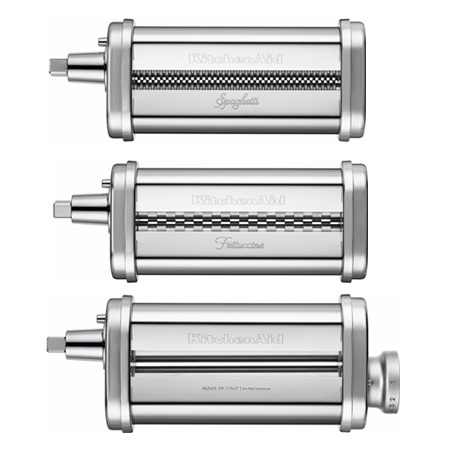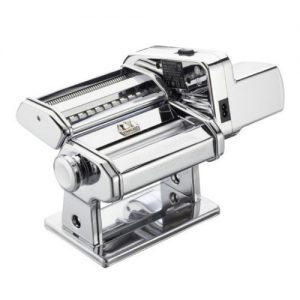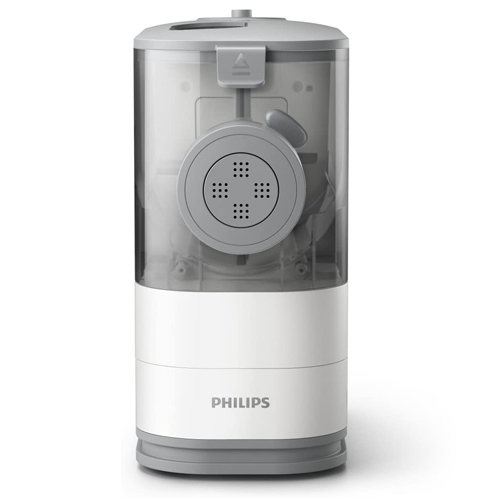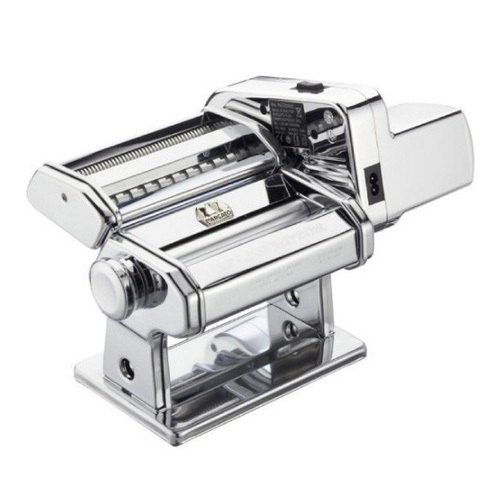For the past eight years I have updated this buyers guide every year. For 2023, our top rated machine, the Philips pasta maker has had a minor model update but otherwise my recommendations remain the same.
Philips, Marcato and KitchenAid are all great choices, but each have their purpose and perfect use. Don’t expect the same result from an extruder. Want traditional, go for rollers & cutters. Read my full buyers guide and buy the best electric pasta maker that suits your needs.
The Philips Pasta Maker is the winner when it comes to the best combination of price, quality and ease-of-use in a fully automatic pasta machine. If you want to eat fresh pasta without having to knead and mix the dough, this is the best choice by far. The Philips doesn’t offer the hands-on versatility that you get with traditional, manual rollers and cutters but it is definitely the best fully automatic pasta machine that I have used.
For a more traditional approach, choose the Marcato Atlas 150 with a motor attachment (Amazon) – plenty of attachments available and you’ll have more control over the whole process.
For owners of a KitchenAid mixer, we recommend to take a look at the official KitchenAid Pasta Maker 3-Piece Attachment Set (Amazon) which is on par with the Marcato Atlas in terms quality and can be used to make pasta the traditional way.
Top 4 best electric pasta makers
Philips Pasta Maker HR2375/06
The Philips Pasta maker is still the best pick if you want to make homemade pasta on the regular without the effort. Fresh pasta in about 20 minutes, the machine mixes & kneads for you and will automatically extrude the pasta. The only drawback in my eyes – misses the mark on authenticity in taste and offers less versatility than a traditional roller & cutter.
KitchenAid 3-Piece Pasta Attachment Set
Best buy if you own a KitchenAid (or a great excuse to buy one) and don’t mind mixing and kneading the pasta dough yourself. Spaghetti, fettuccine and lasagna – high quality motorized rollers that do most of the work for you. Traditional pasta with a touch of modern power.
Marcato Atlas 150 w/ Motor Attachment
Electric version of the Marcato Atlas Wellness. Easy and fast to use with both hands being free, its less work to make homemade pasta. The motor can also be purchased separately & the Marcato can also be used as a traditional roller with the hand crank.
Philips Compact Pasta & Noodle Maker
Great option for smaller batches of pasta, as this compact electric machine takes in half the space of its big brother. Great pasta, although a little bit thicker than with a traditional roller. Extra attachments are available.
Benefits of an electric pasta maker
Making pasta every day with a manual pasta maker can be a chore and it takes quite a bit of time and practice before you can compare it to the speed of an electric machine. For most, an electric pasta maker is faster and easier to use.
One of the main selling points is that you can use both your hands to operate the machine. No hand crank, as you let the machine work its electricity and do the rolling & cutting for you. The result isn’t any different than you would expect from a manual machine. Choosing an electric pasta maker simply has its benefits that a manual machine will never offer.
Besides the classic rollers and cutters, pasta extruders are definitely gaining popularity. No rollers and cutters are involved as these machines do not resemble a traditional roller at all. It can’t get any easier than a pasta extruder – it mixes, kneads and extrudes the dough for you. All you do is throw in the ingredients for the dough and use the scraper to cut off the pasta as the machine forces the pasta out in the desired shape.
Making your own pasta cannot get any easier with the electric Philips Pasta Maker. This all-in-one is one of the best electric pasta extruders that is available on the market. It will mix the dough for you and without almost any effort you will have your pasta ready in 15 minutes. With the Philips Pasta Maker it really is as simple as pressing a button.
The Philips comes with a set of 4 shaping discs that can make the following pasta shapes: spaghetti, fettuccine, penne and lasagna sheets. There are additional attachments available that allow you to make more shapes such as tagliatelle and pappardelle.
In comparison to other electric pasta machines (especially extruders) the Philips is a very silent machine that doesn’t produce a lot of sound, whereas other pasta extruders tend to make a lot of noise when mixing and extruding the pasta. With the Philip’s low production of sound, this isn’t a nuisance at all.
The Philips Pasta Maker has been receiving a lot of love by reviewers since its initial release in 2014, and we agree on the way the cooking community loves this machine: this is definitely the best electric pasta extruder in its price range. Want to know more about this beautiful automatic pasta maker, read our full review on the Philips Pasta Maker.
Short Review: Best in its price class, amazing build quality and easy to clean. Will help you make homemade batches of pasta really quickly. Best consumer electric pasta maker available right now.
If you own a KitchenAid Stand Mixer and you are looking for an electric pasta machine, then you should consider the KitchenAid Pasta Roller set. These attachments can be easily connected to your KitchenAid and all you will have to do is let your dough roll through the cutters and rollers to make perfectly thin pasta.
With these three different rollers that you get with this attachment set you can immediately start making three types of pasta: spaghetti, fettuccine and lasagna sheets. The rollers and cutters are easy to clean with the cleaning brush and toothpicks.
If you don’t own a KitchenAid Stand Mixer at the moment but you are looking for one and for an electric pasta machine as well, you should consider getting both. For around $350 dollar you will have an excellent stand mixer and a top of the line pasta machine. To read more about this set you can check our review on the KitchenAid KPSA Pasta Roller & Cutter Set.
Quick Review: Works perfectly, but a KitchenAid Stand Mixer is necessary if you want to use this attachment. Easy and quick to use, the build quality is what you expect from KitchenAid. In comparison with off-brand attachments for KitchenAid, this is your best choice with the recent price drops. Read the full review on the KitchenAid Pasta Maker here.
Honestly, I am a huge fan of Marcato. The versatility of the machines is amazing, with 17 different attachments available. The Marcato in itself works wonders when you use the hand crank, but the motorized attachment makes the process a lot easier – and quicker! This pasta roller is the ideal kitchen companion for pasta lovers that want a versatile pasta roller that offers you plenty of options besides the three standard attachments: lasagne, spaghetti and fettuccine.
The following attachments are available for the Marcato Atlas 150 models. Lasagne, fettuccine, tagliolini, bucatini, lasagnette, bigoli, capellini, linguine, mafaldine, pappardelle, reginette, spaghetti, spaghetti chitarra, vermicelli, trenette, ravioli and raviolini.
If you don’t own a KitchenAid Stand Mixer at the moment but you are looking for one and for an electric pasta machine as well, you should consider getting both. For around $350 dollar you will have an excellent stand mixer and a top of the line pasta machine. To read more about this set you can check our review on the KitchenAid KPSA Pasta Roller & Cutter Set.
Quick Review: Great build quality and warranty, can be used both as an electric pasta maker and as a manual pasta roller. The past few years this has been the best choice for those looking for a classic pasta roller with motorized functionalities.
December 2019: I’ve read multiple reviews about problems with the motor. I have no experience with a faulty motor and mine continues to work after 3 years.
4. Philips Compact Pasta & Noodle Maker
Great option for smaller batches of pasta, as this compact electric machine takes in half the space of its big brother. Great pasta, although a little bit thicker than with a traditional roller. Extra attachments are available.
While the Philips Compact is both smaller and cheaper than the original Philips Pasta Maker, it makes the same quality pasta. A bit more dense than you’ll get with a classic pasta roller, but there simply isn’t a faster way making fresh pasta.
You add the ingredients: water, flour, salt and optionally eggs. You select the right program and the extruder starts mixing and kneading. Once the machine starts extruding, you get to work and slice of the pasta at its desired length. Really, it doesn’t get easier and less time consuming.
That’s exactly the target audience. A great choice if you want fresh pasta on the regular, without having aspiring dreams to become a pasta artisan.
Electric pasta maker with a small footprint
The small footprint will leave extra space on your kitchen countertop. Its a great machine for both students and smaller families, as it makes 2-3 batches of fresh pasta in just 18 minutes. Yes, from start to finish! After that, all you have to do is cook the pasta in boiling water.
With the machine itself, you’ll get 3 shaping discs for fettuccine, spaghetti and penne. You can store the shaping discs inside the built-in storage. A bonus since 2020, there is a set with shaping discs for angel hair & lasagna available for this compact machine. angel hair and lasagna: the lasagna disc allows you to create a lot more if you decide to use a knife, ravioli stamps and your hands. This made this pasta maker a whole lot more versatile.
Quick review: a great option, especially with the new shaping discs that includes lasagna sheets. Very easy to use and allows you to start experimenting with pasta. Don’t expect real Italian pasta, as this consumer machine has not reached that level yet.
Buying guide: what do you look for in an electric pasta maker?
Traditional rollers & cutters VS all-in-one extruders
There are two types of electric pasta machines: pasta rollers and pasta extruders. Pasta rollers resemble the classic machines where you roll the pasta dough through the rollers, but instead of using a hand crank there is a motorized attachment that will do all the work for you. A pasta extruder is a whole different kind of machine; it pushes the pasta shapes out instead of rolling the pasta dough.
What you need to know: extruders offer speed and ease of use. They offer great tasting pasta, but not traditional Italian. Pasta rollers and cutters give you a lot of freedom and while it takes more practice to learn the skill, you’ll be able to make pasta the same way they do in Bologna – you’ll be making the real deal.
Electric extruders
Electric pasta extruders offer the most shapes of pasta such as penne, macaroni, lasagna and spaghetti. They are the fastest option and most come with a built-in mixer.
Electric roller & cutters
Roll the pasta dough to your desired thickness. These classic machines are great for traditional homemade pasta. Attachments for longer pasta – spaghetti, angel hair, fettuccine, lasagna.
The first major difference between an electric pasta roller and an extruder is the way that both machines work: with a pasta roller you will have to make the pasta dough yourself and with a pasta extruder you will have only have to throw the ingredients for the dough into the machine and it will mix the dough for you. This automatic process can save you a lot of time if you plan on using your pasta maker often.
The second difference between both these electric pasta makers is that pasta rollers and extruders can make different kind of pasta shapes. Both machines can make shapes such as fettuccine, spaghetti and lasagna sheets, but with a pasta extruder you can also easily make shapes such as fusilli and penne. These shapes are also achievable with a pasta roller but this will take a bit more effort than when you are using a pasta extruder.
In the comparison below we have reviewed four electric pasta machines, both extruders and rollers. If you want to read more about these pasta makers, you can read each machine’s individual review on its own page.
There are quite a few different brands out there and I have compared most electric machines available. If you stick with the models I recommend, you’re making a good choice. In comparison to cheaper electric pasta machines, all my recommendations have a great build quality and are versatile in their own way.
Opting in for a cheap pasta maker will most likely result in a bit of anger – cheaper machines use cheaper parts and tend to break a lot quicker. More plastic parts and less quality control don’t make for a great pasta maker, especially when they’re electric.
If you aren’t sure yet if you want a manual or electric pasta maker, check out my guide on choosing the best pasta maker. I’ll explain the differences, what suits your needs more and I’ll show you my favorite five pasta makers, both electric and manual.
Thanks for reading! And as always, buon appetito!
Frequently asked questions when buying an electric pasta maker
There are a lot of questions that you might want an answer to before you purchase an automatic pasta maker. With a lot of different machines available on the market, it might be hard to find the pasta maker that suits your needs the best. The following questions are commonly asked and the answers will help you make the right choice. This section will be slowly expanded, as I keep getting more questions in the comments and with the contact form.
Electric extruder or electric roller?
If you are planning on making pasta on a regular basis, an electric pasta extruder might be the best solution for you. These machines take a lot of work out of your hands, which can proof to be very helpful on those days you find yourself in lack of time. Since pasta extruders mix and extrude the pasta for you, you will have a lot of time to spare on other activities; preparing the sauce, other dishes or flat out other activities that might require your attention. Electric pasta rollers are more popular with people that make pasta only once or twice a week.
Difference electric and automatic pasta maker
There actually is a difference between electric and automatic pasta makers. An electric pasta machine is a machine that is powered by electricity, but this doesn’t mean that the machine itself is fully automatic. A fully automatic pasta maker will the dough and cut the dough for you, whereas an electric pasta maker will roll and cut the dough for you. An automatic pasta maker such as the Philips Pasta Maker takes a lot of work out of your hands, as you will only have to press a few buttons and cut the pasta to choose the length of the pasta that you are making.
Attachments for electric and automatic pasta makers
All the electric pasta makers that have been mentioned in the review above come with a certain set of attachments. The type of pasta that these attachments can produce depend on the pasta maker itself.
The most usual attachments that you will receive with your purchase of an electric pasta maker are the spaghetti, fettuccine and lasagna attachments. The KitchenAid is already the full attachment set for your KitchenAid stand mixer, so you won’t need more attachments if you buy this set. However, you can make a lot of different pasta types without extra attachments by simply using your hands or a ravioli stamp.
Can I make ravioli with an electric pasta maker?
Yes! It’s not that hard to make ravioli, especially with an electric machine – you just need to roll out flat sheets of pasta. You can do this with all machines in this review: the KitchenAid, Marcato and Philips all come with an attachment for lasagna sheets. You can use the sheets to make ravioli by hand by using stamps, rolling cutters or ravioli trays. Alternatively, you can use a ravioli maker – read my pick of the best ravioli makers.
Is it worth the price difference of a manual machine?
This is one of the more common questions that I receive in my inbox. A lot of my readers want to know if it is worth buying an automatic pasta maker over a manual pasta machine. Sadly, the answer isn’t a straightforward yes or no; the answer depends on the person asking. My rule of thumb is that if you want to make pasta multiple times a week or make a big batch once a week, you are best of buying an automatic pasta machine.
What flour should I use for my electric pasta machine?
There isn’t a different type of flour that you should use when making fresh pasta with an electric pasta maker. The only difference might be the ratio of flour, eggs and water when making the pasta. Most pasta makers come with a manual that explains this ratio and might even showcase a few recipes that you can use with your new machine.
Want to know what flour you should use? Check out my guide on pasta flour which contains a list of the best pasta flour. I explain the differences, combinations and the science behind pasta flour.
Philips Pasta Maker
+ Best pasta extruder available
+ Silent compared to other brands
+ Comes with 4 basic pasta shapes
+ A lot of attachments available
+ Easy to clean
– Can’t make real Italian pasta
– Takes up quite some space
Marcato Atlas 150 Wellness with Motor
+ Top of the line pasta maker brand
+ High quality design and materials used
+ Comes with 3 basic pasta shapes
+ A lot of attachments available
+ Small compared to electric pasta extruders
– Mix and knead the pasta dough yourself
KitchenAid KPSA Pasta Roller Set
+ Perfect if you own a KitchenAid Stand Mixer
+ High quality materials and design
+ Easy and intuitive to use
+ Use your KitchenAid to make the dough
– You’ll need a KitchenAid





The Phillips model 2357/06 is no longer available. If you would please provide your next best model choice that would be great. Thanks!
Hi Sandy. Thanks for your comment. You are right – the 2357/06 has been replaced by the 2375/06 which you can find here https://amzn.to/3cLCJiy
I’ll update the article shortly with this information. Thanks again, all the best.
Great comparison! I own the Kitchenaid pasta rolling and cutting set. Is it worth buying the Marcato 150 because I want the extra attachments that are available for it? Or should I stick with my KitchenAid? I also love their design LOL and it would make a great excuse to buy the aluminium model to fit my KitchenAid design. Thank you! Maia
Maia, it’s definitely not necessary but you seem to agree with me on that! If you’ve been making pasta with your KitchenAid you’re probably convinced that fresh pasta is better. I’d say go for it, but don’t splurge money on unnecessary attachments. A lot of shapes you’ll be able to make by hand just fine with a pasta roller.